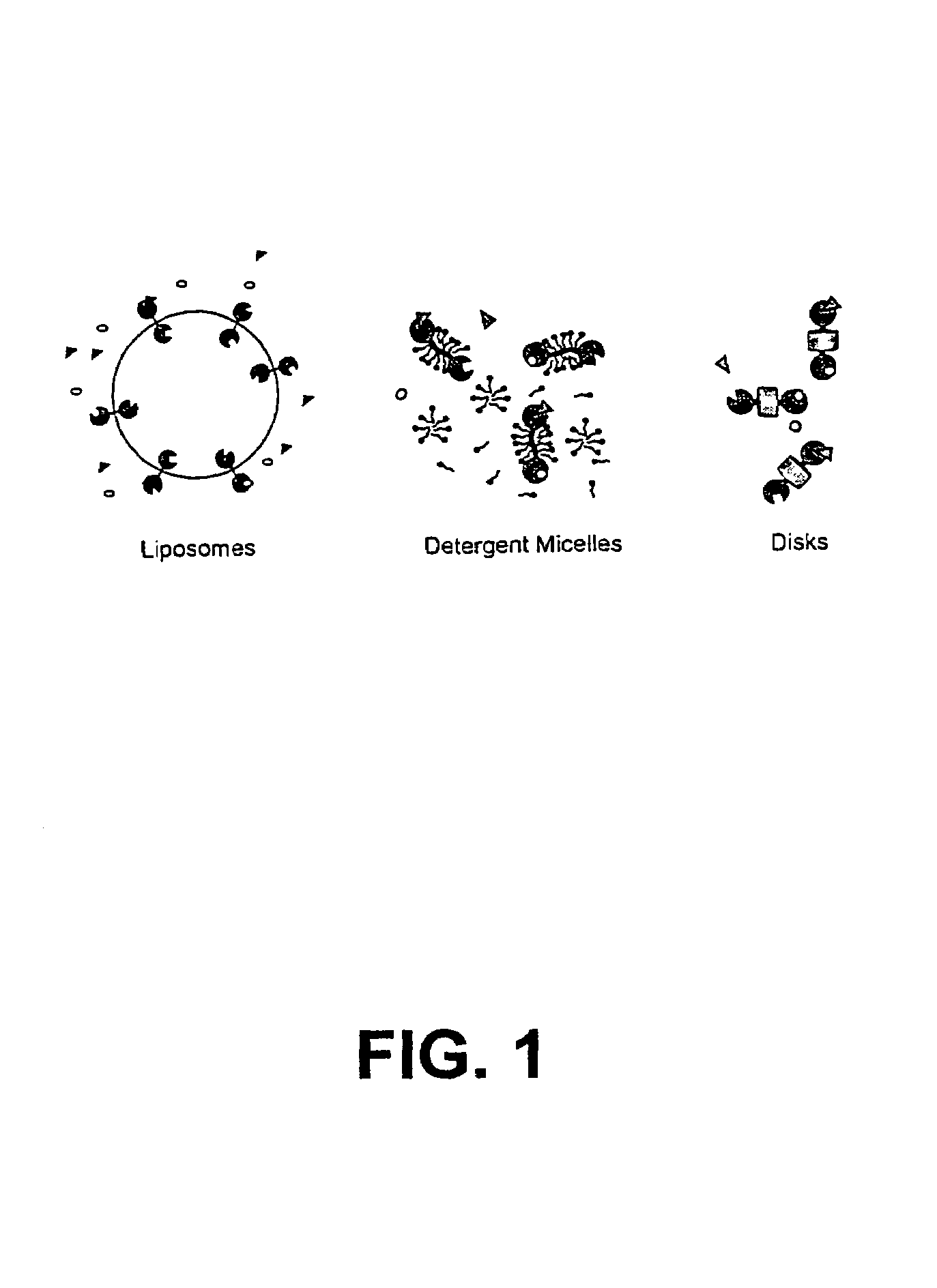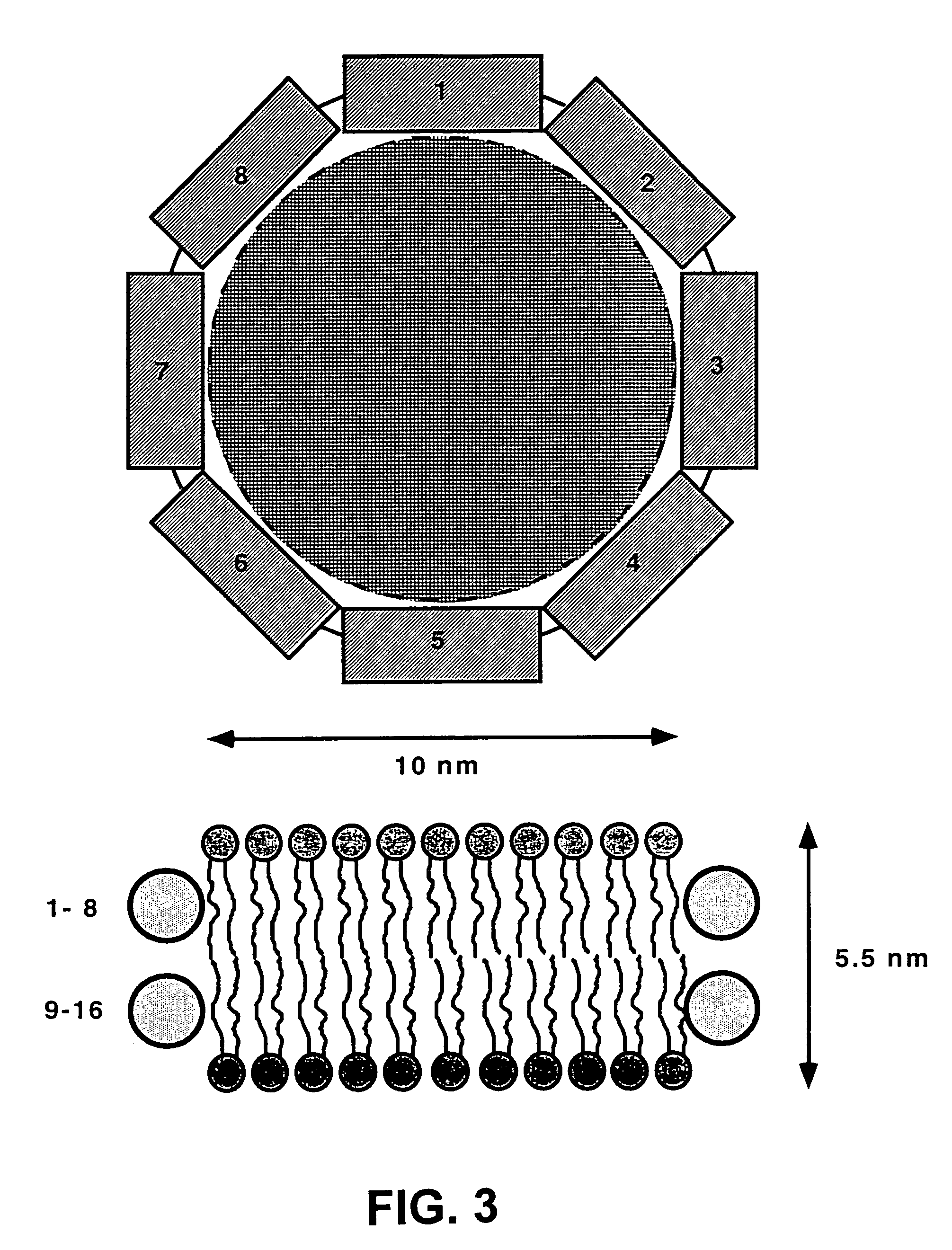Membrane scaffold proteins
a membrane scaffold and protein technology, applied in the field of membrane scaffold proteins, can solve the problems of random orientation of the protein with respect, no complete and direct evidence as to which model is correct, and no three-dimensional structure of the entire particle available to distinguish between, etc., to facilitate understanding the interaction, broaden the signal, and facilitate the effect of stability
- Summary
- Abstract
- Description
- Claims
- Application Information
AI Technical Summary
Benefits of technology
Problems solved by technology
Method used
Image
Examples
example 1
Construction of Recombinant DNA Molecules for Expression of MSPs
[0178]The human proapo A-I coding sequence as given below was inserted between Ncol and Hindlul sites (underlined) in pET-28 (Novagen, Madison, Wis.). Start and stop codons are in bold type. The restriction endonuclease recognition sites used in cloning are underlined.
[0179]
TABLE 1ProApo A-I coding sequence (SEQ ID NO:1) Restrictionsites used in cloning are underlined, and the translationstart and stop signals are shown in bold.CCATGGCCCATTTCTGGCAGCAAGATGAACCCCCCCAGAGCCCCTGGGATCGAGTGAAGGACCTGGCCACTGTGTACGTGGATGTGCTCAAAGACAGCGGCAGAGACTATGTGTCCCAGTTTGAAGGCTCCGCCTTGGGAAAACAGCTAAACCTAAAGCTCCTTGACAACTGGGACAGCGTGACCTCCACCTTCAGCAAGCTGCGCGAACAGCTCGGCCCTGTGACCCAGGAGTTCTGGGATAACCTGGAAAAGGAGACAGAGGGCCTGAGGCAAGAGATGAGCAAGGATCTGGAGGAGGTGAAGGCCAAGGTGCAGCCCTACCTGGACGACTTCCAGAAGAAGTGGCAGGAGGAGATGGAGCTCTACCGCCAGAAGGTGGAGCCGCTGCGCGCAGAGCTCCAAGAGGGCGCGCGCCAGAAGCTGCACGAGCTGCAAGAGAAGCTGAGCCCACTGGGCGAGGAGATGCGCGACCGCGCGCGCGCCCATGTGGACGCGCTGC...
example 2
Construction of Synthetic MSP Gene
[0207]A synthetic gene for MSP1 is made using the following overlapping synthetic oligonucleotides which are filled in using PCR. The codon usage has been optimized for expression in E. coli, and restriction sites have been introduced for further genetic manipulations of the gene.
[0208]
Synthetic nucleotide taps1a (SEQ ID NO:30)TACCATGGGTCATCATCATCATCATCACATTGAGGGACGTCTGAAGCTGTTGGACAATTGGGACTCTGTTACGTCTASynthetic nucleotide taps2a (SEQ ID NO:31)AGGAATTCTGGGACAACCTGGAAAAAGAAACCGAGGGACTGCGTCAGGAAATGTCCAAAGATSynthetic nucleotide taps3a (SEQ ID NO:32)TATCTAGATGACTTTCAGAAAAAATGGCAGGAAGAGATGGAATTATATCGTCAASynthetic nucleotide taps4a (SEQ ID NO:33)ATGAGCTCCAAGAGAAGCTCAGCCCATTAGGCGAAGAAATGCGCGATCGCGCCCGTGCACATGTTGATGCACTSynthetic nucleotide taps5a (SEQ ID NO:34)GTCTCGAGGCGCTGAAAGAAAACGGGGGTGCCCGCTTGGCTGAGTACCACGCGAAAGCGACAGAASynthetic nucleotide taps6a (SEQ ID NO:35)GAAGATCTACGCCAGGGCTTATTGCCTGTTCTTGAGAGCTTTAAAGTCAGTTTTCTSynthetic nucleotide taps1b (SEQ ID N...
example 3
Expression of Recombinant MSPs
[0280]To express MSP proteins, the nucleic acid constructs were inserted between the NcoI and HindIII sites in the pET28 expression vector and transformed into E. coli BL21 (DE3). Transformants were grown on LB plates using kanamycin for selection. Colonies were used to inoculate 5 ml starter cultures grown in LB broth containing 30 μg / ml kanamycin. For overexpression, cultures were inoculated by adding 1 volume overnight culture to 100 volumes LB broth containing 30 μg / ml kanamycin and grown in shaker flasks at 37° C. When the optical density at 600 nm reached 0.6-0.8, isopropyl-β-D-thiogalactopyranoside (IPTG) was added to a concentration of 1 mM to induce expression and cells were grown 3-4 hours longer before harvesting by centrifugation. Cell pellets were flash frozen and stored at −80° C.
PUM
| Property | Measurement | Unit |
|---|---|---|
| height | aaaaa | aaaaa |
| height | aaaaa | aaaaa |
| hydrodynamic pressures | aaaaa | aaaaa |
Abstract
Description
Claims
Application Information
 Login to View More
Login to View More - R&D
- Intellectual Property
- Life Sciences
- Materials
- Tech Scout
- Unparalleled Data Quality
- Higher Quality Content
- 60% Fewer Hallucinations
Browse by: Latest US Patents, China's latest patents, Technical Efficacy Thesaurus, Application Domain, Technology Topic, Popular Technical Reports.
© 2025 PatSnap. All rights reserved.Legal|Privacy policy|Modern Slavery Act Transparency Statement|Sitemap|About US| Contact US: help@patsnap.com



